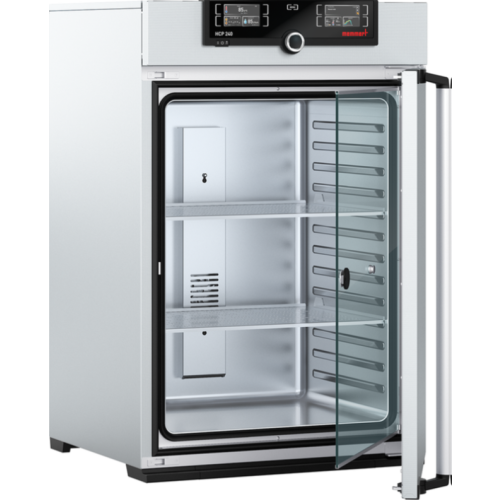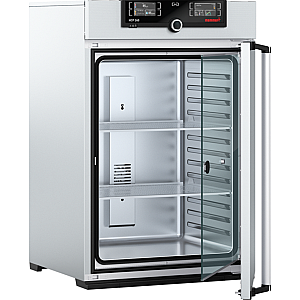The Memmert HCP240 humidity-controlled climate chamber provides a stable and precise environment for accelerated life testing and 85/85 tests. Featuring active humidity control and digital PID regulation, it maintains constant temperature and humidity conditions for research, development and quality assurance applications. Its 241-litre usable volume, stainless steel construction and six-sided heating system guarantee optimum homogeneity and the absence of condensation. Easy to program via its TwinDISPLAY interface and AtmoCONTROL software, it ensures safety, reliability and data traceability.
HCP240 Humidity Chamber


Description
Memmert HCP240 – Humidity-controlled climate chamber for reliability testing
The Memmert HCP240 is a humidity chamber designed to provide precise temperature and humidity control, meeting the needs of laboratories, research centres and quality departments. Thanks to its active humidity control system, it can be used for demanding tests such as accelerated life tests or 85/85 protocols. Its temperature range extends from +7 °C above ambient temperature to +90 °C, and its humidity control covers 20 to 95 % RH, with an adjustment accuracy of 0.5 % RH.
At the heart of the HCP240 is a multifunction digital PID controller with a high-definition dual colour display called TwinDISPLAY. This intuitive tool makes it easy to program and monitor parameters, with the ability to set temperature, relative humidity, programme duration and time zones. The AtmoCONTROL software allows programmes to be managed and transferred via USB or Ethernet, offering easy integration into existing processes.
Robust design for consistent performance
The HCP240 chamber has a net volume of 241 litres, distributed within a corrosion-resistant stainless steel inner chamber (W.-St. 1.4301 / ASTM 304). Its six-sided heating system, supplemented by door and rear wall heating, ensures perfect temperature uniformity while eliminating condensation. The two Pt100 temperature sensors (DIN class A) monitor each other and take over in the event of a failure, providing increased operational reliability.
The design includes an insulated stainless steel door with a two-point lock and a heated glass inner door for observing samples without disturbing the internal conditions. The chamber can accommodate up to twelve perforated stainless steel shelves, for a maximum total load of 140 kg.
Safety, traceability and compliance with standards
To protect your tests and samples, the HCP240 incorporates the AutoSAFETY system, which monitors temperature deviations from the setpoint, triggering a visual and audible alarm and shutting down the heating in the event of overheating. A comprehensive self-diagnostic system ensures rapid detection of any malfunctions related to temperature or humidity control.
The internal documentation stores the programmes in the event of a power failure, ensuring continuity of protocols. Compact and easy to install, it requires only minimal space around the unit to ensure adequate ventilation.
Features
- Active humidity control for accelerated testing and 85/85
- Six-sided heating system with heated doors and walls
- TwinDISPLAY controller with dual high-definition colour display
- Programming and transfer via USB or Ethernet
- SetpointWAIT function to start timing after conditions have stabilised
- AutoSAFETY system with visual and audible alarm
- Self-diagnostic function for temperature and humidity control
- Heated glass inner door
- Corrosion-resistant stainless steel construction
- Factory calibration provided at 60 °C and 75% RH
Technical Details
- Working temperature range: +7 °C above ambient temperature up to +90 °C
- Temperature setting range: +18 °C to +90 °C
- Temperature control accuracy: 0.1 °C
- Relative humidity adjustment range: 20 to 95% RH and RH-off
- Humidity control accuracy: 0.5% RH
- Temperature sensors: 2 Pt100 DIN class A probes, 4-wire connection
- Useful volume: 241 litres
- Internal dimensions (W x H x D): 600 x 810 x 500 mm
- External dimensions (W x H x D): 759 x 1180 x 691 mm
- Maximum load capacity: 140 kg (15 kg per shelf)
- Interface: Ethernet LAN, USB
- Programming: AtmoCONTROL software
- Electrical power: 1840 W
- Voltage: 230 V or 115 V, 50/60 Hz
- Net weight: 110 kg
- Operating ambient temperature range: 10 °C to 30 °C
Compatible Accessories
- Additional perforated stainless steel shelves
- Water tank with connection pipe
- Silicone access port Ø 40 mm with cap
- AtmoCONTROL software on USB stick